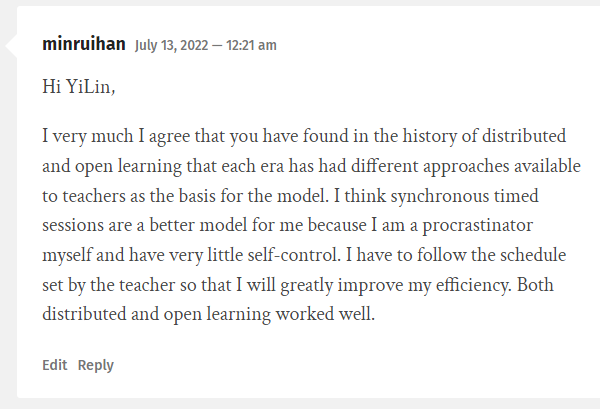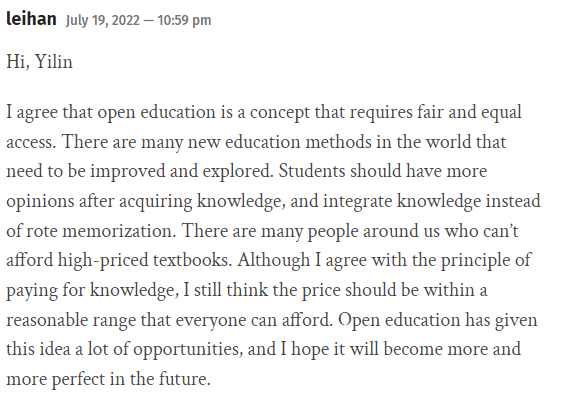EDCI 339 Learning Journey
In this portfolio, you can browse what I learned in EDCI 339 and my new understanding of distributed and open learning.
Learning Outcome #1: Describe the potential of human-centered learning in distributed and open learning contexts.
Topic 1 introduces human-centered learning in distributed and open learning environments. I especially liked Vaughan’s article on teaching in blended learning environments because it gave me a clearer understanding of the terms I encountered before class. The definition and characteristics of distributed and open learning are clearly defined in the article, and the format makes the content easy to grasp.
The authors mention three key elements of a community of inquiry framework built on the belief that “higher education is both a collaborative and an individual constructivist learning experience” (Garrison & Vaughan, 2013). In my blog #1, I also have my opinion on this sentence. I believe every student faces different challenges in this new online learning environment. Through the series of readings in Topic 1, I feel that blended learning somehow better combines the advantages of traditional and online learning, with more independence for professors and students to think about textual content. But in the mode of combining modern education with traditional education, privacy issues deserve our attention.
The “invisibility” and lack of understanding/ambiguity of tracking through EdTech is part of the larger problem today. The problem here is the inability to critically address the looming problems of these systems because they are ignored or obscured. We should review these processes to prevent fragmented systems caused by factors such as socioeconomic status.
The following screenshots of comments posted by my pod member on my blog post, further discussing our views on privacy and how it can limit human-centered learning in distributed learning environments:


We all agree that blended learning is more common now, and the privacy issues revealed by the open learning and distributed learning are the most important. By completing these activities, I learned that I can build a person-centered learning experience by using a distributed and open learning environment. While privacy such as personal information cannot be avoided, the information gained from this learning model is very important. It will help me create a different environment in my future work and life.
Learning Outcome #2: Explore and engage with current literature on the distributed and open education movement.
The two readings in topic 2 discuss the literature sources for the distributed and open education movement. I learned a lot from the distributed learning and open learning history outlined in the two readings. I have found that each era has a different approach that teachers can choose as the basis for the model. In “Teaching Online – A Guide to Theory, Research , and Practice”, the authors break down each individual course model into the following descriptors; Enrollment, Amount, Timing, Platform, and Pathway. Each step corresponds to a different learning method and what to do at this stage.
In “Openness and Education: A beginners’ guide”, the article that attracted me from the beginning was a timeline of the historical evolution of open education. The first phase of the movement began in England in the early 1970s. From “distance education and open learning” in the 1980s to “E-Learning and online online education” in the 1990s, and finally to the interpretation of open learning. Open learning in different eras adheres to the “learner-centered pedagogy”.
Here are some comments on my pod partners which further support my progress and how I have met the outcomes.


Topic 3’s reading expands on the concept of open learning. In “A guide to making open textbooks with students”. the author came up with the concept of Open Educational Resources . The authors propose that OER should be reusable, retainable, redistributable, revisable, and remixable. These are the five important factors of the current open resource and also to identify whether it is an open educational resource.
With all the reading and discussion, I am now able to understand the history of distributed and open learning and keep up to date with the latest developments in the open learning OER.
Learning Outcome #3: Critically reflect on and articulate concepts around modality, pedagogy, and access, including distributed and open learning theory, online and open learning history, privacy laws, online learning communities, open research, and open data.
In topic 1 and topic 2,I discussed distributed and open learning theory, online and open learning history, privacy law, open research, and open data. During the first week, I read about online security and privacy laws that go hand in hand with online, distributed, and open learning. The first reading was British Columbia’s FIPPA legislation (Freedom of Information and Protection of Privacy Act), which includes the right to privacy and an individual’s right to access information controlled by a public agency, including an individual’s right to access their own personal information. The outcome #1 and outcome #2 also specifically talked about these topics.
Topic 4 expands my thinking on open learning beyond just online practice. I learned about the diversity of this definition and our own involvement through EDCI 339. Week 4’s reading material further inspired my understanding of the OER learning model. The authors present a four-part test in supporting OER pedagogy. At the heart of the OER concept are the 5 Rs I mentioned in my topic 3: reusable, retainable, redistributable, revisable, and remixable. In examining whether a practice is a pedagogy that supports OERs, the four-part test examines the linkages of the 5R activities.
The Digital Equity & Perspective project in our pod 4 group researched distributed and open learning theories and determined which learning medium is best for our persona’ learning.
Here is the chart and pitch for our Digital Equity & Perspective project:


Through my Pod project, I was also able to examine the theory of distributed and open learning and how it can be applied in practical ways to improve the learning experience for students.
Learning Outcome #4: Examine and reflect upon the potential for equitable access for all learners in online and open learning contexts.
I learned how online software, often used by schools for personalized, student-centered, or adaptive learning, is run by big data companies that use student data and information in topic 1’s reading. Although it is intended to be used to classify students and direct appropriate learning, it is often discriminatory and the information collected about students may create inequities or unequal access to students.
This discrimination leaves many students unequal in online and open learning. And my team members feel the same way as I do:

The reading of Topic 3 expands the content of open learning. An important principle of open learning is the concept of fair and equal access, providing educational resources to the public to encourage individuals to pursue knowledge without the complexities of going to an educational institution or following special guidance. From the learner’s perspective, one principle of open learning is the ability to learn and contribute from learning material. Textbooks are required for many courses during studies, and textbooks provide excellent material for review and study. However, textbooks are very expensive compared to other books. Some people may be reluctant to take it.
Expensive textbooks and limited online resources have kept many would-be learners from getting the chance to learn, and the advent of Open Educational Resources (OER) has changed inequality. OERs generally stand for broader online content and can be considered open educational resources. The authors propose that OER should be reusable, retainable, redistributable, revisable, and remixable. I believe this is perhaps the best encapsulation of open learning and open learning material.
Here are some comments on my pod partners which further support my progress and how I have met the outcomes.


By completing these activities, I learned that an unfair education system and teaching resources can create unfair learning environment for different groups of students. It is important to acknowledge these learning disabilities, and effective teaching strategies, such as through OER, will be developed to reduce gaps in learning outcomes and create a more inclusive environment.
Learning Outcome #5: Conduct research into and critically reflect upon emerging and future educational technologies.
In topic 2‘s reading, I discussed “Teaching Online – A Guide to Theory, Research, and Practice”. In many of the open and distributed education courses listed in this article, professors use a range of multimodal techniques including visual, design, audio, web and video to help students learn new cultures. For my EDCI 339’s blog , I am also using it for the first time, and editing and sharing it with others.
The open education resources in Topic 3 will also become a prominent resource library in future open education. The Wikipedia model and the five characteristics of OER applied. Everyone is free to edit and upload their views. More and more online education platforms have begun to accept and learn this model.
Showcase Blog
Changes in Bold.
Updated blog 3:
Original blog 3:
Thank you for journeying my EDCI 339 learning outcomes.
Reference:
Regan, P., & Jesse, J. (2019). Ethical challenges of edtech, big data and personalized learning: Twenty-first century student sorting and tracking. Ethics and Information Technology, 21(3), 167-179. DOI: 10.1007/s10676-018-9492-2
Vaughan, N. D., Garrison, D. R., & Cleveland-Innes, M. (2013). Teaching in blended learning environments: Creating and sustaining communities of inquiry. AU Press.
· Chapter 1: Conceptual Framework
Major, C. H. (2015). Teaching Online – A Guide to Theory, Research, and Practice. Retrieved from http://ebookcentral.proquest.com/lib/uvic/detail.action?docID=3318874 (pp. 76-108)
Jordan, K. & Weller, M. (2017). Openness and Education: A beginners’ guide. Global OER Graduate Network.
Mays, E. (Ed.). (2017). A guide to making open textbooks with students. Rebus Community.
Wiley, D. & Hilton, J. (2018). Defining OER-enabled Pedagogy. International Review of Research in Open and Distance Learning, 19(4).
FIPPA legislation in British Columbia.
Kral, I. & Schwab, R.G. (2012). Chapter 4: Design Principles for Indigenous Learning Spaces. Safe Learning Spaces. Youth, Literacy and New Media in Remote Indigenous Australia. ANU Press. http://doi.org/10.22459/LS.08.2012